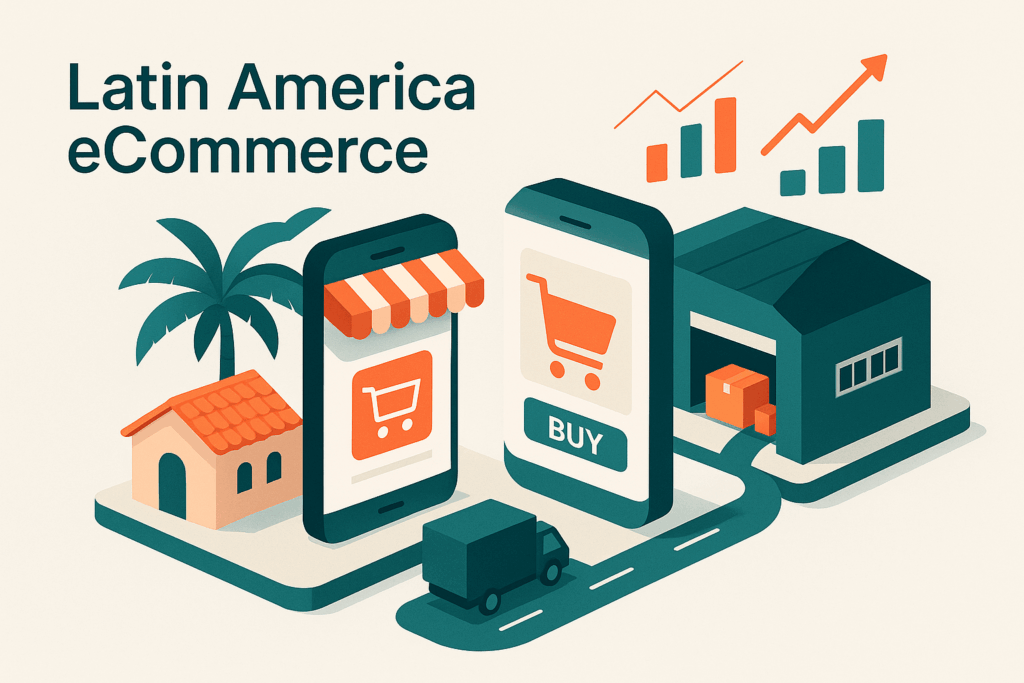Manufacturing and industrial businesses thrive. As a business owner with an eCommerce store, there has never been a better time to harness this growth.
Industrial products are integral to countless sectors and enterprises. This article will teach you how to market industrial products online.
Demand for efficient and innovative industrial products has grown steadily over the past few decades. Consequently, total sales in the industrial product market have also seen substantial growth.
At this pace, total industrial product spending could surpass significant milestones in the coming years.
While machinery might dominate this sector, there are a myriad of other product types that can thrive in this market.
Your products might be top-notch and ahead of the curve. But without an effective marketing strategy, your potential clientele will remain unaware of what you bring to the table.
Marketing industrial products should not be approached like other goods or services. It’s a specialized field that requires distinct strategies for success. A one-size-fits-all marketing plan won’t suffice.
As an expert in eCommerce marketing and SEO strategies for manufacturers, I’ll guide you through the nuances of effectively marketing and launching your industrial products. Here are some basic Industry Statistics:
Manufacturing Output: As of 2021, the U.S. manufacturing sector produced over $2.3 trillion in output, making it the world’s second-largest manufacturing output, closely following China. U.S. manufacturing would rank ninth in the world.
Jobs: Manufacturing businesses in the U.S. directly employ over 12 million individuals, accounting for nearly 9% of the workforce. What’s even more significant is that for every direct manufacturing job, there are another four jobs created in related sectors.
Energy Consumption: The industrial sector, which includes manufacturing, agriculture, construction, and mining, consumes about 33% of the total U.S. energy usage. This sector is highly reliant on non-renewable energy sources, making it a prime target for sustainable energy initiatives.
Exports: Approximately 60% of all U.S. exports are manufactured goods. This dominance underscores the importance of the manufacturing and industrial sector to the country’s trade balance and global economic influence.
Research & Development (R&D): U.S. manufacturers led in R&D investments among all domestic sectors. As of the latest data, they contributed about $230 billion, accounting for over 63% of all private-sector R&D spending. This focus on innovation underscores the sector’s importance in driving technological advancements and productivity gains.
These figures highlight the undeniable weight and influence of industrial businesses on shaping the U.S. economy, workforce, and global positioning.
Understand The Industrial Buyer’s Needs
Utilizing emotions to increase sales is a timeless marketing tactic. But industrial products can be uniquely tailored.
There’s an emotional aspect to selling industrial products.
Your customers have a stake in the industries they operate in. They view their equipment and machinery as the key to their success and efficiency.
This is a significant selling point. You can use this insight to elicit an emotional response from your business-to-business customers.
For instance, suppose you’re unveiling an innovative machinery component. You could initiate a campaign that emphasizes the safety and efficiency improvements your component offers compared to others on the market.
Customers won’t compromise on components that guarantee better safety and increased productivity for their operations. They might invest more in these types of offerings.
Indeed, studies indicate that businesses are often willing to allocate a larger budget to industrial products that promise durability, safety, and efficiency. Particularly, new businesses or startups might be more inclined to invest in top-tier equipment even if they’re working with tighter budgets than established companies.
Every one of your marketing campaigns should tap into these emotional considerations.
I’d suggest initiating or collaborating with initiatives that focus on sustainable and eco-friendly industrial solutions. 63% of businesses prefer to partner with green brands. Companies are even prepared to allocate higher budgets for eco-friendly products.
Why? Green initiatives and sustainability-centered branding resonate emotionally.
Business owners and decision-makers are becoming increasingly aware of the broader implications of their industry choices. They’ll appreciate the added value when their purchases contribute to a more sustainable and environmentally-conscious industry.
Trending industrial products to succeed in the industrial sector, it’s crucial to market products that businesses genuinely need. It’s futile to offer products that are incompatible with current industry demands.
Based on industry trends, the following are some of the most sought-after products in the industrial sector currently:
- Energy-efficient machinery
- Industrial IoT devices (monitoring, data analytics, tracking, etc.)
- Precision tools and calibration equipment
- Industrial cleaning solutions (degreasers, rust removers, etc.)
- Safety gear and equipment
- Workbench and modular workstation systems
- Vehicle and machinery protective covers
- Conveyor systems and material handling equipment
- Specialized lubricants and coolants
- Industrial uniforms and protective clothing
- Storage and warehousing solutions
- Quality control and inspection tools
- Training equipment (simulation software, safety drills, etc.)
- Packaging solutions and containers
- Slow-motion machinery for precision tasks
- Robotics and automation tools
- Industrial software solutions
- Eco-friendly and sustainable materials
- Renewable energy solutions
- Waste management and recycling tools
As highlighted earlier, machinery forms a significant chunk of the market share in industrial spending. So, your industrial business should consider offering machinery and related components to cater to your clientele.
In addition, you can also provide supporting products, similar to the other items listed above.
Categories in Industrial Products
It’s essential to understand that industrial goods are not homogeneous. Here are some of the prominent categories:
- Raw materials: Ores, minerals, and agricultural products
- Manufacturing equipment: Machines, computer systems, and assembly devices
- Business supplies: Office equipment, lubricants, uniforms, etc.
- Parts and components: Circuit boards, motors, and batteries
- Business services: Consulting, auditing, and IT services
Strategies to Market Industrial Products
Marketing industrial products present a unique set of challenges, often because the target audience is more niche, and the sales cycles can be longer than in consumer markets. To achieve optimal visibility and position your products as industry leaders, here are detailed strategies you can adopt:
SEO & Content Marketing for Industrial Product Domination
Diving deep into industrial products demands a more surgical approach than traditional consumer goods. Here’s how to fine-tune your strategies for this niche:
1. Search Engine Optimization (SEO): Precision in Discovery
- Understand Your Industrial Audience: Are plant managers looking for “automated assembly line solutions”? Or perhaps engineers are researching “high-tolerance machining tools”? Take a closer look at these specialists’ unique challenges and needs.
- Keyword Research with Industrial Precision: Using tools like Google Keyword Planner or Ahrefs, pinpoint terms like “corrosion-resistant pipe fittings” or “high-capacity hydraulic pumps” that potential buyers might input.
- On-Page SEO with Industrial Specs: For a page on “multi-axis CNC machines,” not only should keywords be prevalent, but technical specifications, weight capacities, and tolerances should be highlighted for added relevance.
- Backlink Building in Industry Circles: Pursue backlinks from authoritative sites like “Industrial Equipment Weekly” or guest posts on niche forums like “Modern Manufacturing Methods.” Being part of directories such as “Global Machinery Suppliers” can also amplify your industry footprint.
2. Content Marketing: A Deep Dive into Industry Insights
- Prioritize Quality with Technical Depth: A three-page deep dive into “the advantages of titanium fasteners in high-pressure environments” is more valuable than ten generic articles on fasteners.
- Diverse Formats for Complex Narratives: An infographic on “The Lifecycle of an Industrial Furnace” or a webinar on “Optimizing Factory Floor Layouts” can convey intricate subjects more clearly than text alone.
- In-Depth Guides for Industrial Use: How-to guides like “Installing & Calibrating Pressure Relief Valves” or “Maintenance Schedules for Industrial Compressors” cater directly to those using or considering your products.
- Real-World Applications & Feedback: Showcase a case study on “How Our Drilling Rig Increased Oil Extraction by 30%” or solicit testimonials from a factory manager praising the efficiency of your “automated packaging solution.”
- Targeted Promotion for the Niche Audience: Share your latest piece on “Benefits of Modular Construction in Industrial Settings” on LinkedIn groups like “Future of Industrial Construction,” or partner with publications such as “Factory Management Today” for wider outreach.
Mastering Google AdWords for Marketing Industrial Products
Navigating Google AdWords for industrial products demands precision and tailored strategies. Unlike consumer products, industrial products serve a niche market, have unique requirements, and cater to a knowledgeable audience. Let’s delve deeper into using Google AdWords effectively for these distinct products.
1. Benefits of Google AdWords in the Industrial Sector
- Immediate Exposure for Niche Products: Google AdWords propels your industrial product, such as “heavy-duty centrifugal pumps” or “industrial-grade conveyor belts,” to the forefront, bypassing the organic ranking wait time.
- Tailored Reach: Industrial decision-makers are specific in their search. AdWords can help you target professionals searching for “stainless steel vat manufacturing” or “CNC machine calibration.”
- Dynamic Adjustments: React swiftly to market demands, such as an uptick in “PPE manufacturing equipment” during health crises.
2. Keyword Selection for Industrial Markets
- Focused Keyword Research: Tools like Google’s Keyword Planner can help you pinpoint precise terms like “hydraulic press for automotive parts” or “large-scale industrial refrigeration.”
- Study the Competition: Understand which terms competitors in the industrial space target. Are they focusing on “3-phase industrial generators” or perhaps “modular assembly line systems”?
- Leverage Negative Keywords: To ensure precision, exclude irrelevant terms. For example, if you sell “industrial-grade paint mixers,” you might want to exclude “household paint mixers.”
3. Crafting Industrial-Specific Ads
- Specialized Ad Copy: Highlight unique specifications or compliance standards. An ad for “FDA-approved pharmaceutical manufacturing equipment” would catch the right attention.
- Employ Ad Extensions: Use extensions to highlight key features. For an “industrial welding robot,” you could have extensions like “AI-driven precision” or “multi-material compatibility.”
- Relevant Landing Pages: If your ad promotes “aerospace-grade alloy smelting,” ensure the landing page dives deep into specifications, certifications, and applications in aerospace.
- A/B Testing with Industry Context: Test ads by showcasing different USPs. For “industrial water filtration systems,” one ad might emphasize “99.9% contaminant removal” while another highlights “5-year maintenance-free operation.”
4. Monitoring and Refinement in an Industrial Context
- Industry-Specific CTR: A low CTR on an ad for “bulk chemical storage solutions” might indicate the need to highlight different features like “corrosion-resistant” or “temperature-controlled.”
- Conversion Focus: Ensure that clicks on “heavy machinery lubrication systems” ads lead to inquiries, RFQs, or direct purchases.
- Periodic Audits with an Industrial Lens: While auditing, consider industry trends. If “sustainable energy solutions for factories” is trending, adjust your bids and ad strategies accordingly.
In conclusion, industrial products demand a sophisticated approach to Google AdWords. By harnessing its power with a keen understanding of the industrial landscape, manufacturers and suppliers can achieve remarkable visibility and conversions in their niche market.
Retargeting in the Industrial Realm: Keeping Precision Equipment Top-of-Mind
Navigating the intricacies of industrial product marketing demands a keen understanding of the unique buying cycle. Retargeting becomes essential, especially given the niche audience and high-ticket values of machinery and tools. Here’s how to sharpen your retargeting strategy for industrial wares:
1. The Industrial Buyer’s Journey
Industrial purchasing decisions are not made randomly. For instance, a facility manager might peruse heavy-duty “turbine generators” or research “large-scale wastewater treatment plants.” They’ll likely visit multiple sites, ponder the options, and maybe even bookmark a few. They might leave without initiating contact. This is where retargeting becomes crucial.
2. Pixel-Based Retargeting: Recapturing the Interested Audience
- Tailored Product Reminders: If an engineer spent time on your page detailing “High-Efficiency Steam Boilers,” use pixel-based retargeting to serve ads highlighting the unique features or benefits of that exact boiler model as they browse other sites.
- Highlight Real-World Applications: Serve ads that show your “industrial-grade conveyor system” in action at a renowned manufacturing plant, creating a compelling visual cue for a product they’ve already shown interest in.
- Promote Content They Missed: Perhaps they read about your “CNC precision lathe” specs but missed the customer testimonial video. Retarget them with content that fills gaps in their initial exploration.
By harnessing retargeting, you’re not merely reminding potential buyers about your products; you’re strategically positioning your industrial equipment or solution as the most appealing choice they initially considered, nudging them closer to that crucial decision point.
Maximizing Exposure for Industrial Goods: Google Shopping & YouTube Tactics
In the complex landscape of industrial sales, visual marketing is indispensable. Buyers often need to see machinery or parts in detail before making a purchasing decision. Here’s how to strategically utilize Google Shopping and YouTube for your industrial products:
1. Google Shopping: A Visual Window into Your Industrial Arsenal
- High-Res Images for Detailed Equipment: When listing a “3-phase induction motor” or a “stainless steel hydraulic cylinder,” make sure your images are in high resolution, allowing potential buyers to zoom in and see detailed craftsmanship and part specifications.
- Detailed Product Data Submission: Uploading to Google Merchant Center isn’t just about basic details. For a product like an “automated assembly line robot,” include specifics such as load capacity, arm reach, speed, and compatibility with other systems. Make sure certifications (e.g., “ISO 9001 Certified”) are prominent.
2. Video & YouTube Marketing: Bringing Industrial Products to Life
- In-Depth Tutorials for Complex Machinery: If you’re selling a “CNC plasma cutting machine,” a step-by-step tutorial showing setup, calibration, and actual cutting operations can demystify the product for potential buyers.
- Webinars for Niche Audience Engagement: Host sessions focused on emerging technologies, like “Advancements in Cleanroom Robotics.” Engage industry experts to discuss the benefits and applications of your specific product range.
- Real-World Case Studies: A video showcasing how your “modular conveyor system” increased efficiency in a prominent car manufacturing plant offers tangible proof of its benefits. Use graphics to emphasize improvements in throughput or downtime.
In conclusion, for industrial products, visuals, and demonstrations can make or break a sale. Through Google Shopping’s visual listings and YouTube’s comprehensive video content, potential buyers get a clearer, closer look at what you offer, greatly influencing their purchase decisions.
Harnessing Trade Shows for Industrial Outreach: A Spotlight on Tangible Demonstrations
In the world of industrial machinery and solutions, sometimes a brochure or online listing simply won’t cut it. There’s an irreplaceable value in live demonstrations and real-world interactions, especially when it comes to intricate, high-stakes equipment. Here’s how trade shows and industry events elevate the marketing game for specialized industrial products:
1. The Live Showcase of Industrial Innovations
- Tactile Experience: Imagine displaying the latest “Vibration-Resistant Industrial Lathe.” At a trade show, engineers can feel its build quality, see the machine in operation, and assess its noise levels firsthand – experiences impossible to replicate online.
- Real-Time Demonstrations: For a product like a “High-Pressure Chemical Reactor,” you can run live simulations, showing how efficiently it handles reactions, its safety features in action, and the ease of cleaning and maintenance.
2. Direct Engagement with Targeted Stakeholders
- Interactive Q&A Sessions: After showcasing a “Next-Gen Industrial 3D Printer,” hold a live Q&A. You can ask questions about material compatibility, printing speeds, or how it integrates with existing manufacturing systems.
- Feedback Loop Creation: The insights from potential buyers – say, after witnessing the demo of a “Robotic £Welding Arm” – can be invaluable. They might provide feedback on desired features, potential applications, or even usability improvements.
3. Networking with industry pillars
- Forge Supplier and Distributor Relations: Participate in events like “Global Industrial Automation Expo.” You might find distributors interested in your product line of “AI-Driven Material Sorters.”
- Engage with Thought Leaders: Attending events allows conversations with industry experts. Their endorsements or feedback, especially on products like “Eco-Friendly Industrial Boilers” or “Modular Factory Automation Systems,” can shape your product’s trajectory and market reception.
In summation, while digital means have revolutionized industrial marketing, there’s an enduring power in hands-on demos and face-to-face interactions. For industrial magnates, trade shows and industry events remain a potent avenue to not just showcase, but truly immerse potential buyers in their product offerings.
Strategic Alliances in the Industrial Landscape: Expanding Horizons with Collaborative Ventures
In the intricate industrial sector, collaboration often becomes the linchpin of growth. Unlike simpler sectors, industrial products and services are often interlinked in intricate supply chains, manufacturing processes, and operational ecosystems. Let’s delve into the potency of partnerships, especially in the realm of specialized business offerings:
1. Mutual Growth Through Complementary Pairings
- Machinery and Maintenance Synergy: Consider a manufacturer of “High-Torque Industrial Drilling Units.” Collaborating with a company that specializes in “Routine Maintenance & Servicing of Drilling Equipment” can be invaluable. Both parties can bundle their offerings, ensuring clients get a complete package – from purchase to after-sales service.
- Integrated System Solutions: If a firm produces “Automated Conveyor Belt Systems,” partnering with a business that focuses on “Warehouse Inventory Management Software” can result in a holistic warehouse solution, enhancing efficiency and broadening market reach.
2. Tapping into Established Distribution Networks
- Access to New Geographies: A European manufacturer of “Precision CNC Machines” might find it challenging to break into the Asian market. By forming a strategic alliance with a well-established local distributor, they can gain insights into local industrial needs and also ensure smooth logistics and delivery processes.
- Cross-Promotion Opportunities: Suppose a company specializes in “Industrial Safety Gear,” from helmets to protective suits. Forming a partnership with a firm producing “Industrial Machinery Safety Protocols and Training” allows both to promote each other. Clients purchasing machinery training can be referred to the most appropriate safety gear, and vice versa.
3. Collaborative Innovation for Futuristic Solutions
- Joint R&D Initiatives: Collaborating on research and development can propel innovation. Imagine a “Hydraulic Pump Manufacturer” and a “Smart Sensor Developer” working together. The resulting product might be a self-monitoring, AI-driven pump that predicts maintenance needs and optimizes performance in real time.
- Pooling Resources for Training & Workshops: Companies producing “Advanced Robotics” and “Robotics Programming Software” can collaborate to host workshops, demonstrating the prowess of their integrated products to potential buyers.
Industrial sectors thrive on interdependence. Through judicious partnerships and collaborations, companies can bolster their product offerings but also create a ripple effect of growth, innovation, and expansive market penetration.
Tapping into B2B Platforms for Industrial Visibility: Navigating the Powerhouses
For purveyors of specialized industrial equipment and solutions, visibility in the right spaces is paramount. In the bustling world of business-to-business transactions, platforms like Alibaba, ThomasNet, and their ilk have emerged as key epicenters for industry professionals seeking quality and reliability. Here’s how to strategically leverage these platforms to spotlight your industrial offerings:
1. Alibaba: The Global Marketplace for Industrial Goods
- Tailored Product Listings: If you’re a manufacturer of “Heavy-Duty Conveyor Systems,” your listing should emphasize unique selling points, like “Modular Design” or “AI-Enhanced Load Balancing.” High-resolution photos and videos can demonstrate the product’s robustness and efficiency.
- Market Insights: By observing trends and buyer behaviors on Alibaba, suppliers of niche products, say “Graphene-based Industrial Lubricants,” can identify emerging markets or sectors where their product could gain traction.
2. ThomasNet: America’s Premier Industrial Directory
- Certification and Verification: For a supplier of “CNC Machining Centers,” being part of ThomasNet comes with third-party verification. The platform’s emphasis on American suppliers and verifiable quality can enhance your brand’s credibility among discerning buyers.
- Industry-Specific Listings: ThomasNet allows granular categorization. If you’re selling “Explosion-Proof Electrical Components,” ensure they’re listed in the right sub-categories, like “Petroleum Processing” or “Chemical Manufacturing Equipment.”
3. Navigating Other B2B Platforms
- Geo-Specific Platforms: Depending on your target market, consider platforms dominant in specific regions. For instance, a producer of “Solar-Powered Industrial Chillers” eyeing the European market might consider platforms popular in that region, ensuring their product is visible to the right audience.
- Engage in Platform Communities: Many B2B platforms foster communities or forums. Engage actively, offer insights, and address queries. For example, if there’s a discussion about “Optimal Filtration Systems for Paint Factories,” and you produce “Nano-Filtration Membranes,” it’s an opportunity to showcase your expertise and product relevance.
To wrap up, B2B platforms, with their industry-specific focus and vast reach, present a golden opportunity for industrial product suppliers. By positioning products aptly and engaging actively on these platforms, suppliers can carve out a niche and build lasting relationships with industrial buyers.
In the intricate realm of industrial product marketing, it’s critical to grasp the specific nuances and needs of the sector. From raw materials like rare earth metals crucial for electronics, to state-of-the-art CNC machines reshaping manufacturing, each segment has its unique demand curve and audience. Consider business supplies; the choice of an eco-friendly lubricant over a conventional one could directly influence a company’s sustainability quotient. Similarly, advancements in components like lithium-ion batteries can revolutionize sectors from automotive to renewable storage. Then, there are specialized business services—take, for instance, IT solutions tailored for the manufacturing sector, ensuring seamless integration of floor operations with cloud data analytics. As businesses pivot towards more efficient and tech-driven solutions, those marketing industrial products must delve deep into these specifics. Recognizing the intricacies of each sub-sector, from raw materials to advanced robotics, is the true cornerstone of effective industrial product marketing.
Industrial Marketing FAQ
Why does marketing for industrial products differ from that for consumer goods?
Industrial product marketing targets a specific audience, often involving complex machinery or tools, such as CNC machines or conveyor belt systems. This contrasts with consumer marketing, which deals with everyday items like smartphones or sneakers. A majority of industrial marketing transactions tend to be high-value, targeting a niche audience like manufacturing plant managers, rather than the broad consumer base.
How crucial is digital marketing for machinery and industrial components?
Vital! As businesses increasingly look for industrial solutions online, a robust digital footprint ensures your heavy-duty drill presses or industrial automation systems are found by the right decision-makers in the manufacturing sector.
What significance do industrial trade exhibitions hold for machinery marketing?
Industrial trade shows are pivotal. They offer an opportunity to demonstrate large-scale machinery, engage with potential customers like factory owners or engineers, and foster partnerships with other industry players.
How often should machinery users provide feedback?
Consistently! Feedback from users, especially those operating heavy machinery like lathes or milling machines, is invaluable. This consistent input helps refine your products and align them with industrial needs.
Is it imperative to optimize industrial product websites for search engines?
Without a doubt. SEO ensures that when a plant manager or procurement specialist searches for “high-capacity industrial pumps” or “precision welding equipment,” your products appear prominently, maximizing visibility and potential sales.
Whether you need help with SEO, content marketing, Google AdWords, or a comprehensive digital strategy tailored to your industrial products, Optimum7 has the expertise and resources to help your business succeed.
Don’t leave your potential for success to chance. Let’s explore how we can collaborate to elevate your industrial product marketing strategy and connect you with the clients that need your products the most.
Contact Us Today and let us help you transform your marketing game. Reach out to us and let’s create impactful marketing strategies for your industrial products!










